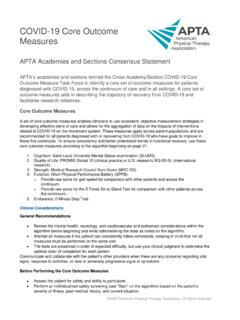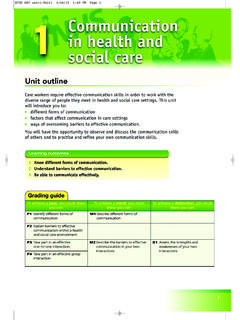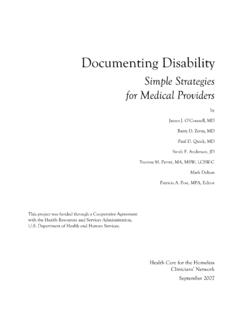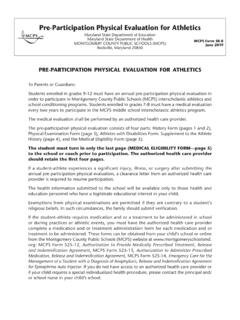Transcription of Inclusion In Physical Education And School Sports - pdnet
1 Inclusion In Physical Education And School Sports CONTENTS. Inclusion in Physical Education 1. The Inclusion Spectrum 3. Warm Up Activities 5. PE and Sports Athletics - Jumping / Throwing 7. Athletics - Running / Races 8. Badminton 9. Basketball 10. Cricket 11. Dance 12. Football 13. Games 14. Games Ball Skills 15. Gymnastics 16. Hockey 17. Netball 18. Outdoor and Adventurous Activities 19. Rounders 21. Rugby 22. Swimming 23. Table Tennis 25. Tennis 26. Volleyball 27. Disability Sports Boccia 29. Floor Lacrosse 30. New Age Kurling 31. Polybat 32. Table Cricket 33. Sports Day 34. Circle Games 38. BAALPE - Safe Practice in Physical Education 40.
2 BAALPE - Risk Assessment form 41. Equipment Suppliers 43. Resources, Books, CD / Useful Contacts 44. Inclusion IN Physical Education . Physical Education is a practical subject that enables all children to participate in exciting and challenging Physical activities, which can generate good health and fitness. PE provides opportunities for the development of Physical , personal, social and intellectual skills, plus it encourages co-operation, positive actions, positive thinking, tolerance and respect for others. PE promotes the undertaking of exercises that can be continued into adulthood as part of a healthy lifestyle.
3 Most children follow a generalised development of movements and skills a natural progression develops from the simple to the more complex. Initially children learn basic movements within the context of their own body then gradually begin to integrate these movements with one another. PE sessions need to allow for variety and flexibility within activities - children with Physical disabilities will need time and space plus encouragement to perfrom simple activities well. All children should be included in PE and Sport activities most of the time;. Skilful youngsters will need to be challenged with harder activities Less able youngsters will require simpler activities or skills broken down into their component parts PE activities can be modified in a variety of ways.
4 Equipment colour, shape, length of handle, size, texture, weight Interaction ability grouping or pairing, feeding ( ball), safe zones (no marking), playing outside the games area, varying team numbers Position adjusting posture to suit the activity, sideways to throw, alternating the intensity, using tactile guidelines to aid orientation Rules additional lives', changing rules to aid Inclusion , different ways of playing, simplifying a game, rotating rules, creating specific rules Space distance travelled, height / length of barrier, size of the playing area, use of a zoned playing area Speed varying speeds, slower or faster, using still' apparatus, large golf' tee The STEP framework can be used to help adapt and modify activities.
5 S SPACE Where will the activity take place? T TASK What is happening? E EQUIPMENT What is being used? P PEOPLE Who is involved? 1. It is important to recognise the potential gains for children with Physical disabilities through Inclusion in the School 's PE curriculum. PE can help children develop their personal and social skills and enhance Physical development. Personal skills Buliding confidence and rasing self-esteem Developing self-help skills, dressing Learning the importance of listening and following insrtructions Promoting an awareness of risk and safety Reaching goals, raising potential and experiencing a sense of satisfaction Physical skills Helping general coordination and developing balance Improving gross motor skills Increasing spatial and body awareness Providing exercise and promoting fitness Providing Physical challenge and developing self control Social skills Achieving fun and enjoyment through Physical activity Developing social skills and collaborative learning Feeling part of a group and being accepted by peers Promoting participation and a sense of being included in the group Working as part of a team and feeling valued 2.
6 THE Inclusion SPECTRUM. Physical Education sessions aim to develop a child's motor skills both gross motor and fine motor plus body awareness. Team games promote social development and co-operation through turn taking with peers. Children with Physical disabilities should be encouraged to take an active part in Physical Education . Disabled pupils can play a full, practical and meaningful role in their Physical Education games lessons.' (Stevenson and Black, 1999). OPEN ACTIVITIES. After warm-up exercises ( dishes / domes) open activities could include: Cones knocking down or standing up the cones Pelter - teams throw small balls to move a large ball to the opposition Soft ball fight teams throw balls / pom-poms trying to hit the opposition What time is it Mr Wolf?
7 Children stop moving when the teacher turns round 3. MODIFIED ACTIVITIES. PE activities can be modified in a variety of ways: Equipment colour, shape, length of handle, size, texture, weight Space distance travelled, height / length of barrier, size of the playing area, use of a zoned playing area Rules additional lives', changing rules to aid Inclusion , different ways of playing, simplifying a game, rotating rules, creating specific rules Speed varying speeds, slower or faster, using still' apparatus, large golf' tee Interaction ability grouping or pairing, feeding ( ball), safe zones (no marking), playing outside the games area, varying team numbers Position adjusting posture to suit the activity, sideways to throw, alternating the intensity, using tactile guidelines to aid orientation.
8 PARALLEL ACTIVITIES. In parallel activities children play different versions of the same game. Badminton - hitting a balloon or beach ball using a flat hand, racket or glove- bat progressing to using a badminton racket Cricket bowling underarm and using a soft ball with a plastic bat, or using a larger ball placed on a tee, scoring by measuring the distance hit. DISABILITY Sports ACTIVITES. When non-disabled children take part in an activity that has a disabled sport focus this is termed reverse integration', Boccia (a type of bowls game), Goal ball. Wheelchair events include basketball, tennis and volleyball. SEPARATE ACTIVITIES.
9 There are a wide range of disability Sports programmes, including athletics, basketball, table cricket, football, tennis, volleyball. During separate activities' all players can practise and develop their individual skills. FURTHER INFORMATION. The English Federation of Disability Sport , SportPark Loughborough University, 3 Oakwood Drive, Loughborough, Leicestershire LE11 3QF, Telephone: 01509 227750 Website Youth Sport Trust, SportPark Loughborough University, 3 Oakwood Drive, Loughborough, Leicestershire LE11 3QF, Telephone:01509 226600 Website: Safeguarding Deaf and Disabled Children in Sports , Website: 4. WARM-UP ACTIVITIES.
10 Warming up at the beginning of a PE session and cooling down at the end, are important aspects of the whole session. In order to function appropriately muscles need to be stretched and warmed so they do not pull or tear. Stretching helps to release muscles and increase flexibility. Warm-ups help raise the pulse rate and cardio vascular system plus improve mobility. Children should be encourageded to partcipate as independently and safely as possible It is useful to consult with the child's physiotherapist to find out which stretches are beneficial and if there are any which the child should not do The excitement of being part of a warm-up activity can raise the heart rate of children with limited mobility Wheelchair users who require a walking frame can take part in gentle walking exercise gradually progressing to moving more quickly.





